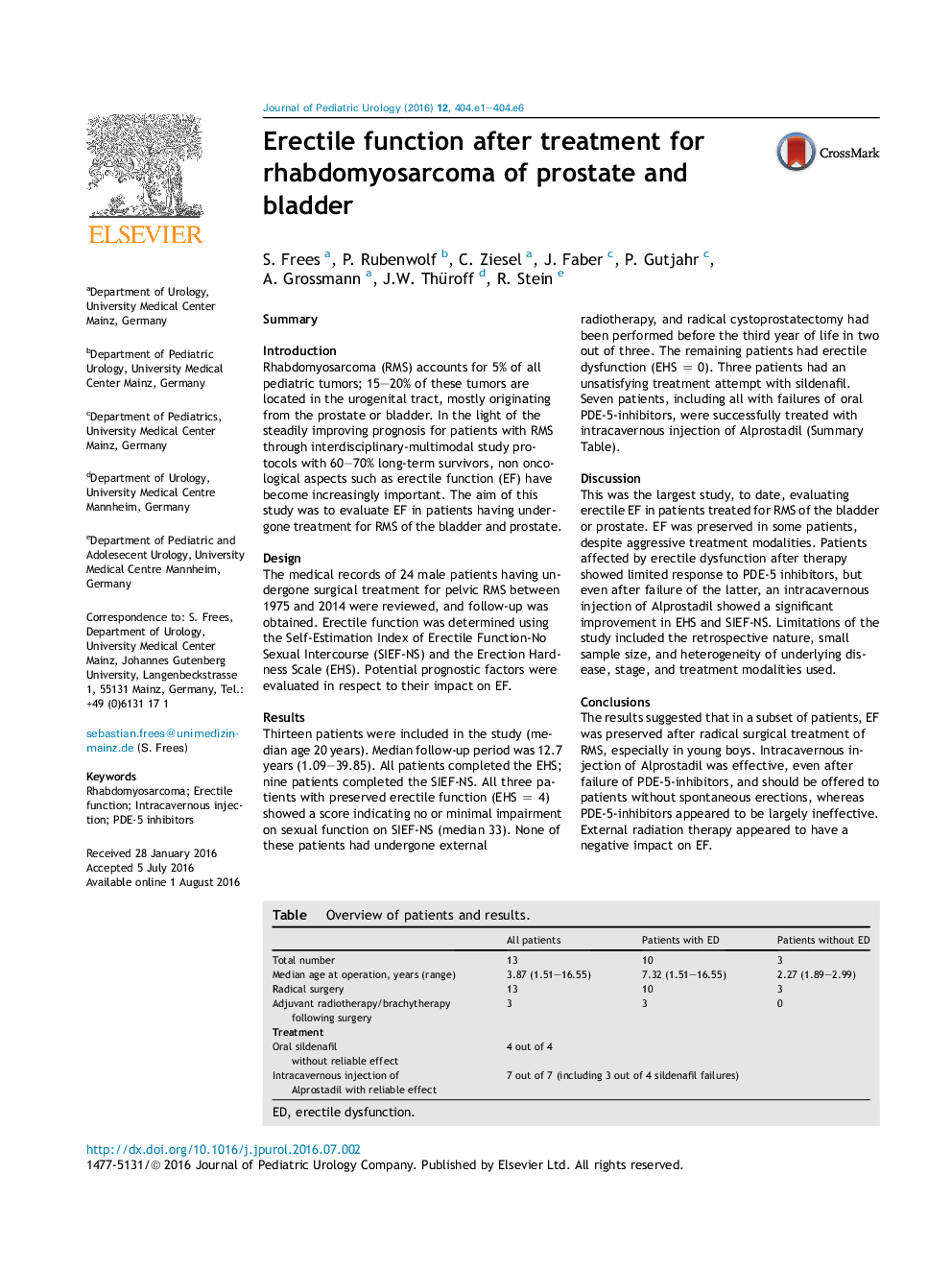| کد مقاله | کد نشریه | سال انتشار | مقاله انگلیسی | نسخه تمام متن |
|---|---|---|---|---|
| 5718728 | 1411256 | 2016 | 6 صفحه PDF | دانلود رایگان |
SummaryIntroductionRhabdomyosarcoma (RMS) accounts for 5% of all pediatric tumors; 15-20% of these tumors are located in the urogenital tract, mostly originating from the prostate or bladder. In the light of the steadily improving prognosis for patients with RMS through interdisciplinary-multimodal study protocols with 60-70% long-term survivors, non oncological aspects such as erectile function (EF) have become increasingly important. The aim of this study was to evaluate EF in patients having undergone treatment for RMS of the bladder and prostate.DesignThe medical records of 24 male patients having undergone surgical treatment for pelvic RMS between 1975 and 2014 were reviewed, and follow-up was obtained. Erectile function was determined using the Self-Estimation Index of Erectile Function-No Sexual Intercourse (SIEF-NS) and the Erection Hardness Scale (EHS). Potential prognostic factors were evaluated in respect to their impact on EF.ResultsThirteen patients were included in the study (median age 20 years). Median follow-up period was 12.7 years (1.09-39.85). All patients completed the EHS; nine patients completed the SIEF-NS. All three patients with preserved erectile function (EHSÂ =Â 4) showed a score indicating no or minimal impairment on sexual function on SIEF-NS (median 33). None of these patients had undergone external radiotherapy, and radical cystoprostatectomy had been performed before the third year of life in two out of three. The remaining patients had erectile dysfunction (EHSÂ =Â 0). Three patients had an unsatisfying treatment attempt with sildenafil. Seven patients, including all with failures of oral PDE-5-inhibitors, were successfully treated with intracavernous injection of Alprostadil (Summary Table).DiscussionThis was the largest study, to date, evaluating erectile EF in patients treated for RMS of the bladder or prostate. EF was preserved in some patients, despite aggressive treatment modalities. Patients affected by erectile dysfunction after therapy showed limited response to PDE-5 inhibitors, but even after failure of the latter, an intracavernous injection of Alprostadil showed a significant improvement in EHS and SIEF-NS. Limitations of the study included the retrospective nature, small sample size, and heterogeneity of underlying disease, stage, and treatment modalities used.ConclusionsThe results suggested that in a subset of patients, EF was preserved after radical surgical treatment of RMS, especially in young boys. Intracavernous injection of Alprostadil was effective, even after failure of PDE-5-inhibitors, and should be offered to patients without spontaneous erections, whereas PDE-5-inhibitors appeared to be largely ineffective. External radiation therapy appeared to have a negative impact on EF.Table. Overview of patients and results.All patientsPatients with EDPatients without EDTotal number13103Median age at operation, years (range)3.87 (1.51-16.55)7.32 (1.51-16.55)2.27 (1.89-2.99)Radical surgery13103Adjuvant radiotherapy/brachytherapy following surgery330TreatmentOral sildenafil without reliable effect4 out of 4Intracavernous injection of Alprostadil with reliable effect7 out of 7 (including 3 out of 4 sildenafil failures)ED, erectile dysfunction.
Journal: Journal of Pediatric Urology - Volume 12, Issue 6, December 2016, Pages 404.e1-404.e6
